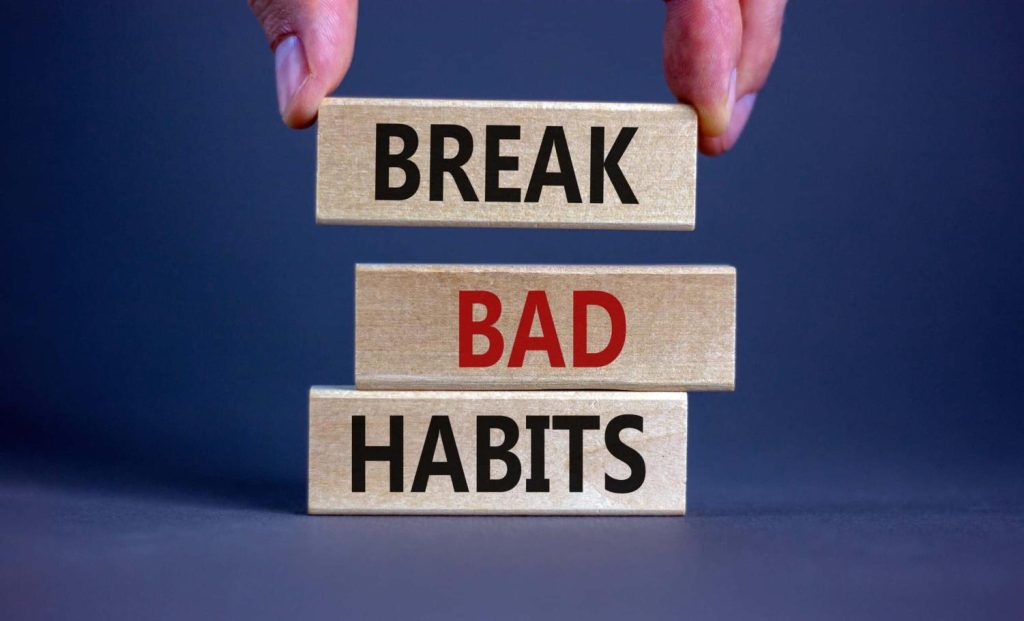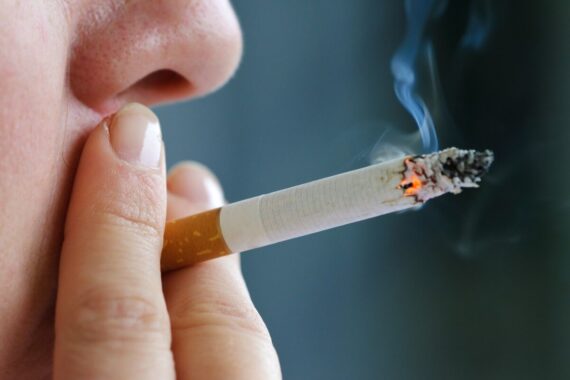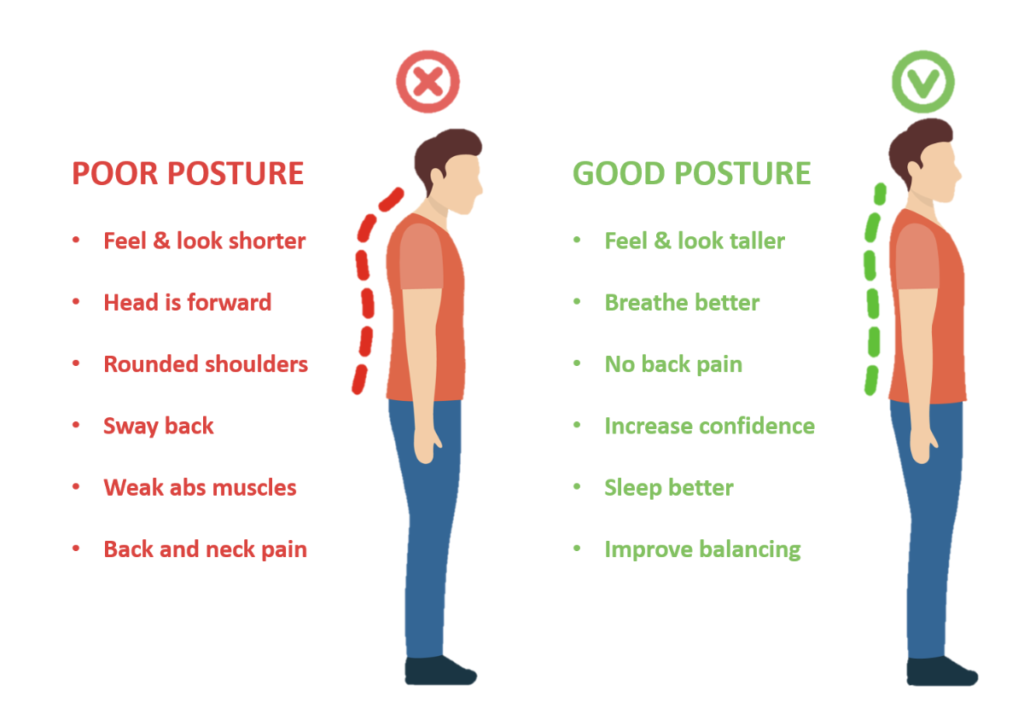- Home
- Self Improvement / Productivity
- 10 Harmful Habits You Need to ...

The Silent Saboteurs in Your Daily Life
You’re curled up on the couch, phone in hand, mindlessly scrolling through TikTok at 1 a.m. “Just five more minutes,” you tell yourself—but an hour later, you’re still awake, dreading tomorrow’s exhaustion. Or maybe you’re stress-eating a bag of chips after a grueling workday, only to feel guiltier with every crunch. Sound familiar?
These small, repetitive actions—harmful habits—might seem harmless in the moment, but over time, they chip away at your health, productivity, and happiness. Whether it’s procrastination, emotional eating, or doomscrolling, these harmful habits act like slow poison, eroding your potential. The good news? With awareness and science-backed strategies, you can replace these patterns with choices that uplift rather than undermine. Let’s dive in.
Why Your Brain Clings to Harmful Habits?
Harmful habits aren’t moral failures—they’re neurological shortcuts. As Charles Duhigg explains in The Power of Habit, habits form through a cue-routine-reward loop:
- Cue: A trigger (stress, boredom, time of day).
- Routine: The automatic behavior (scrolling, snacking).
- Reward: The temporary relief or pleasure (dopamine hit).
The brain’s basal ganglia stores these loops to conserve energy, making harmful habits feel automatic. Breaking them requires rewiring neural pathways—a challenge, but not impossible. NIH research shows that consistency and replacement strategies can forge new, healthier loops in as little as 21 days.
10 Harmful Habits to Break (And What to Do Instead)

1. Procrastination: The Anxiety Amplifier
Why It’s Harmful?
Procrastination isn’t just laziness—it’s a self-sabotaging cycle that fuels chronic stress and erodes self-trust. When you delay tasks, your brain remains in a state of low-grade anxiety, releasing cortisol (the stress hormone) that weakens immunity and disrupts sleep. Over time, these harmful habits lead to burnout, missed opportunities, and a nagging sense of inadequacy. A 2025 study in the Journal of Behavioral Medicine found that chronic procrastinators have a 40% higher risk of hypertension and depression.
Triggers
Procrastination thrives in the face of overwhelm, perfectionism, or fear of failure. Complex projects with unclear first steps often paralyze progress, as the brain interprets ambiguity as a threat. Social pressure, like fearing criticism from peers, can also trigger avoidance. For example, Mark, a freelance writer, noticed he procrastinated most when faced with ambiguous client feedback. His brain interpreted uncertainty as a threat, pushing him toward distractions like YouTube or online shopping. Even boredom with repetitive tasks—like data entry or household chores—can ignite these harmful habits, as the mind seeks immediate gratification over long-term rewards.
Science-Backed Fix:
- The 2-Minute Rule: Commit to starting a task for just two minutes. Often, momentum kicks in.
- Time Blocking: Schedule tasks in 25-minute chunks (Pomodoro Technique).
Real-Life Win: Sarah, a project manager, reduced her procrastination by using Focus@Will playlists to stay in “flow state” during work hours.
2. Excessive Screen Time Before Bed

Why It’s Harmful?
Scrolling through devices before bed isn’t just a time-suck—it’s a biological disruptor. Blue light from screens suppresses melatonin production, delaying sleep onset and reducing REM sleep quality. Poor sleep is linked to weight gain (due to ghrelin hormone spikes), impaired cognitive function, and a weakened immune system. A 2024 NIH study found that nightly screen use increases the risk of insomnia by 65%, making this harmful habit a silent thief of rest.
Triggers
These harmful habits often stem from emotional numbing or a lack of evening routines. For many, screens become a crutch to avoid processing stress or loneliness. The fear of missing out (FOMO) on social updates or news cycles can also trap users in endless scrolling. Rachel, a nurse working night shifts, turned to TikTok to decompress after work but found herself trapped in a cycle of sleeplessness and daytime fatigue. Without structured wind-down rituals, the brain defaults to passive screen consumption, mistaking it for relaxation.
Science-Backed Fix:
- Screen Curfew: Use apps like Freedom to block devices 1 hour before bed.
- Replace with: Reading or a mindfulness app like Calm.
Real-Life Win: *Mark swapped late-night scrolling for journaling and improved his sleep quality by 40% in two weeks.*
3. Negative Self-Talk

Why It’s Harmful?
Negative self-talk—like “I’m such a failure” or “I’ll never get this right”—rewires your brain to focus on flaws, shrinking confidence and decision-making abilities. Over time, these harmful habits activate the amygdala (the brain’s fear center), increasing anxiety and depression risk. A 2025 study in Cognitive Therapy and Research found that self-criticism reduces problem-solving skills by 30%, trapping individuals in cycles of doubt.
Triggers
These mentally harmful habits often flare up during high-pressure situations, such as presentations or deadlines, where the stakes feel personal. Social comparisons—like scrolling through Instagram and measuring your life against curated highlight reels—also feed self-criticism. Past trauma, such as childhood experiences of harsh criticism, can resurface during moments of vulnerability. Lisa, a marketing executive, realized her negative self-talk spiked after team meetings where she received constructive feedback. Her brain conflated professional growth with personal failure, igniting a cascade of self-doubt.
Science-Backed Fix:
- Cognitive Reframing: Challenge negative thoughts with evidence (e.g., “I’ve handled tough projects before”).
- Gratitude Practice: Write three wins daily.
Expert Insight: “Self-compassion activates the prefrontal cortex, boosting resilience,” says psychologist Dr. Emma Lopez.
4. Emotional Eating

Why It’s Harmful?
Emotional eating temporarily numbs stress but creates cycles of guilt, blood sugar crashes, and metabolic dysfunction. Over time, these harmful habits can lead to insulin resistance, weight gain, and disordered eating patterns. A 2023 American Journal of Clinical Nutrition study linked emotional eating to a 50% higher risk of type 2 diabetes, as the body struggles to manage erratic glucose spikes.
Triggers
These harmful habits are often sparked by emotional voids, such as loneliness or unresolved grief, where food becomes a substitute for connection. Celebratory rituals—like rewarding a promotion with cake—can also reinforce the link between food and achievement. Stress hormones like cortisol amplify cravings for salty or sweet foods, creating a biological pull toward comfort eating. Jake, a remote worker, turned to sugary snacks during afternoon slumps, only to crash harder an hour later. His brain learned to associate sugar with temporary relief, deepening the cycle.
Science-Backed Fix:
- HALT Technique: Ask, “Am I Hungry, Angry, Lonely, or Tired?” before eating.
- Swap For: Herbal tea, a brisk walk, or calling a friend.
Real-Life Win: Lisa replaced midnight ice cream with yoga and lost 8 pounds while reducing anxiety.
Fuel Your Body with Intention
Breaking the emotional eating cycle isn’t just about avoiding triggers—it’s also about nurturing your body with Healthy foods that stabilize mood and energy. When cravings strike, reach for nutrient-dense snacks like crunchy veggies with hummus, a handful of almonds, or dark chocolate (70%+ cocoa) to satisfy sweetness without the crash. Building meals around fiber-rich whole grains, lean proteins, and healthy fats helps regulate blood sugar, reducing the rollercoaster of cravings that emotional eating thrives on.
5. Smoking/Vaping

Why It’s Harmful?
Nicotine addiction isn’t just a lung killer—it accelerates skin aging, stains teeth, and increases heart disease risk by 200%. Vaping, often perceived as “safer,” still delivers harmful chemicals like formaldehyde, linked to lung scarring. These harmful habits also rewire dopamine receptors, making joy harder to find in everyday moments.
Triggers
Social rituals, such as smoke breaks with coworkers, normalize these harmful habits by tying them to camaraderie. Many mistakenly believe nicotine calms nerves, unaware that withdrawal symptoms create the illusion of stress relief. Sensory cues—like the smell of coffee or alcohol—can also reignite cravings, as the brain associates these triggers with past routines.
Science-Backed Fix:
- Nicotine Replacement Therapy: Patches or gum.
- Behavioral Swap: Chew gum or use a fidget spinner during cravings.
2024 Trend: QuitGenius app offers personalized CBT programs.
6. Excessive Caffeine Consumption

Why It’s Harmful?
Overloading on caffeine (500+ mg daily) strains the adrenal glands, causing jitters, insomnia, and dependency. Chronic overuse is linked to acid reflux, elevated blood pressure, and anxiety disorders. This habit masks fatigue rather than addressing its root causes, like poor sleep or dehydration.
Triggers
Midday energy crashes often drive these harmful habits, as individuals reach for coffee instead of addressing sleep or nutrition gaps. Social rituals, like coffee meetings or “espresso breaks,” normalize overconsumption. For remote workers, caffeine becomes a crutch to power through unstructured schedules.
Science-Backed Fix:
- Golden Ratio: Pair coffee with L-theanine (found in green tea) for calm focus.
- Hydrate First: Drink water before caffeine to avoid dehydration.
7. Poor Posture

Why It’s Harmful?
Slouching compresses lungs (reducing oxygen intake), strains neck muscles (triggering migraines), and misaligns the spine. Long-term, these harmful habits contribute to degenerative disc disease and chronic back pain. Poor posture also projects low confidence, impacting social and professional interactions.
Triggers
Desk jobs with improper ergonomics—like low monitors or unsupportive chairs—force the body into unnatural positions. Prolonged phone use, often dubbed “text neck,” strains cervical vertebrae. Fatigue or weak core muscles make maintaining posture feel exhausting, perpetuating the cycle.
Science-Backed Fix:
- Ergonomic Setup: Use a standing desk or lumbar cushion.
- Posture Apps: Upright Go vibrates when you slouch.
8. Skipping Meals

Why It’s Harmful?
Skipping meals slows metabolism, spikes cortisol (storing belly fat), and triggers overeating later. This harmful habit also impairs focus—a 2024 study found that meal-skippers perform 25% worse on cognitive tasks, as the brain lacks glucose for optimal function.
Triggers
Busy schedules and diet culture’s glorification of “intermittent fasting” normalize meal-skipping. Stress can suppress appetite, tricking individuals into believing they don’t need fuel. For example, Emma, a startup founder, often forgot lunch during back-to-back meetings, only to binge on snacks at night.
Science-Backed Fix:
- Meal Prep: Keep protein bars or nuts handy.
- Mindful Eating: Schedule meal alarms on your phone.
9. Sedentary Lifestyle

Why It’s Harmful?
Sitting for 8+ hours daily increases heart disease risk by 90%, weakens muscles, and reduces blood flow to the brain (harming memory). Dubbed “the new smoking” by the Journal of the American Heart Association, this harmful habit is a stealthy contributor to chronic illness.
Triggers
Remote work habits blur the line between “work time” and “movement time,” keeping people glued to desks. Fatigue or lack of motivation—often exacerbated by poor sleep or nutrition—makes exercise feel daunting. Open-plan offices without walking paths or standing desks worsen the issue.
Science-Backed Fix:
- Micro-Workouts: 5-minute stretches or squats hourly.
- Walk & Talk: Replace sit-down meetings with walking calls.
10. Overworking

Why It’s Harmful?
Chronic overworking leads to burnout, a state of emotional/physical exhaustion linked to heart disease, insomnia, and relationship breakdowns. A 2024 WHO report labeled burnout a “global occupational hazard,” driven by this pervasive, harmful habit.
Triggers
Hustle culture glorifies busyness, equating self-worth with productivity. Fear of job insecurity—especially in competitive industries—pushes individuals to prioritize work over health. Poor boundary-setting, like answering emails at midnight, normalizes constant availability.
Science-Backed Fix:
- Time Blocking: Use Toggl Track to cap work hours.
- Boundary Rituals: A post-work walk to signal the day’s end.
How to Break Harmful Habits Effectively?
Breaking harmful habits requires more than willpower—it demands strategy, self-compassion, and a deep understanding of your triggers. Below, we unpack science-backed steps to dismantle harmful habits and replace them with routines that serve your well-being.
Step 1: Identify Triggers
Harmful habits thrive in predictable environments. Start by tracking your behavior for a week using a journal or apps like HabitBull. Note the when, where, and why behind your harmful habits. For example:
- Do you smoke when stressed?
- Scroll mindlessly when lonely?
- Overeat during late-night boredom?
Understanding these patterns helps you anticipate and disrupt the cue-routine-reward loop driving harmful habits. A 2023 study in Behavioral Science found that people who identified triggers were 3x more likely to quit harmful habits like emotional eating or procrastination.
Step 2: Start Small with the “2-Minute Rule”
James Clear’s Atomic Habits emphasizes starting tiny to avoid overwhelm. For harmful habits like procrastination or excessive screen time, commit to a micro-action:
- Instead of: “I’ll work for 4 hours straight.”
- Try: “I’ll write one email (2 minutes).”
This reduces friction, making it easier to bypass resistance. Over time, these micro-wins rewire your brain to associate the new habit (e.g., working) with rewards, not the harmful habits you’re replacing.
Step 3: Build Accountability
Harmful habits often flourish in secrecy. Combat this by:
- Partnering Up: Share your goal with a friend (e.g., *“I’m quitting late-night snacking—check in with me at 9 p.m.!”*).
- Joining Communities: Subreddits like r/GetMotivated or apps like Habitica gamify progress, turning habit-breaking into a team effort.
- Public Commitment: Post your goal on social media. The fear of public “failure” can override harmful habits.
A 2024 Journal of Applied Psychology study found that accountability partners increased success rates by 65% for breaking harmful habits like smoking or overspending.
Step 4: Celebrate Micro-Wins
Harmful habits persist because they offer instant gratification (e.g., stress relief from smoking). To compete, reward yourself for small victories:
- Finished a task without procrastinating? Take a 5-minute dance break.
- Skipped the 3 p.m. soda? Enjoy a fancy herbal tea.
These rewards release dopamine, reinforcing the new habit. As neuroscientist Dr. Tara Swart notes, “Celebrating progress no matter how small—rewires the brain to crave the new routine over the harmful habits.”
Recognizing When Harmful Habits Require Professional Intervention
While many harmful habits—like procrastination, emotional eating, or excessive screen time—can be managed with self-awareness and lifestyle adjustments, there are critical moments when these behaviors cross into dangerous territory. Harmful habits become urgent concerns when they escalate into addiction, disrupt daily life, or severely impact mental or physical health. Understanding these warning signs is key to preventing long-term consequences and reclaiming control.
Signs Your Harmful Habits Have Become Unmanageable
- Loss of Control: You repeatedly try to quit the habit but relapse, despite negative consequences (e.g., financial strain, relationship conflicts, or health decline).
- Physical or Psychological Dependence: Withdrawal symptoms like anxiety, irritability, or nausea arise when you attempt to stop the behavior.
- Impaired Functioning: The habit interferes with work, school, or caregiving responsibilities (e.g., missing deadlines due to compulsive gambling or substance use).
- Isolation or Secrecy: You hide the habit from loved ones or withdraw socially to engage in it.
- Escalating Risk-Taking: The behavior becomes riskier over time (e.g., increasing substance dosages, gambling larger sums, or engaging in unsafe behaviors).
Types of Harmful Habits That Demand Professional Support
- Substance Abuse: Alcohol, drugs, or prescription medication misuse.
- Behavioral Addictions: Compulsive gambling, gaming, shopping, or pornography consumption.
- Technology Dependence: Obsessive social media use, doomscrolling, or binge-watching.
- Disordered Eating: Binge eating, restrictive dieting, or purging.
- Self-Harm: Cutting, burning, or other forms of intentional physical injury.
Why Professional Guidance Matters
Harmful habits often stem from deeper emotional wounds, trauma, or untreated mental health conditions like anxiety, depression, or ADHD. Therapists and addiction specialists use evidence-based approaches—such as Cognitive Behavioral Therapy (CBT), Dialectical Behavior Therapy (DBT), or trauma-informed care—to address root causes and equip you with healthier coping mechanisms. Support groups like SMART Recovery or 12-Step programs (e.g., Alcoholics Anonymous) also provide community accountability, which is vital for long-term recovery.
Take the First Step: Resources for Breaking Free
If harmful habits are eroding your quality of life, consider these actions:
- Consult a Therapist: Platforms like Psychology Today or BetterHelp connect you with licensed professionals specializing in addiction.
- Join a Support Group: Peer-led groups (in-person or online) foster connection and shared strategies.
- Crisis Hotlines: Text or call organizations like SAMHSA’s National Helpline (1-800-662-HELP) for immediate guidance.
- Medical Intervention: In cases of substance dependence, supervised detox programs ensure safety during withdrawal.
Ignoring harmful habits can lead to irreversible damage, but reaching out for help is a sign of strength, not weakness. Recovery is not about perfection but progress, and every small step toward support counts.






